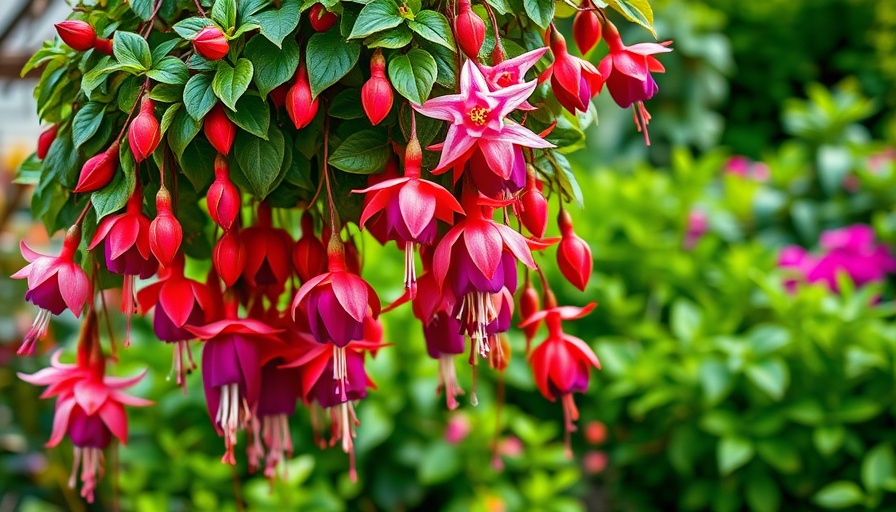
Unlocking the Art of Pruning Fuchsias: A Gardener's Friend
Pruning fuchsia plants can seem daunting at first, but it's one of the most rewarding gardening tasks you can take on. Unlike other flowering shrubs, fuchsias are incredibly resilient and forgiving, making them perfect for both novice and seasoned gardeners alike. So if you’re unsure about how to approach pruning your fuchsia, you’re in luck. This guide will break down all you need to know to encourage those beautiful blooms in your garden.
Why Pruning is Essential for Fuchsias
The primary reason to prune your fuchsia is to promote a healthier and more robust plant. Pruning reshapes the structure of the plant and encourages more flowering the following season. Fuchsias bloom at the tips of their stems, so by carefully trimming back some of the branches, you're effectively increasing the number of flowering tips. This means you’ll enjoy more vibrant blooms in your backyard!
Moreover, it’s not just about aesthetics; a well-pruned fuchsia is less susceptible to diseases and pests. When you remove dead or diseased branches, you ensure that the plant can focus its energy on new growth. For instance, hanging baskets bursting with colorful fuchsias in local garden centers are the result of precise and strategic pruning techniques that maximize blooms.
When to Prune Your Fuchsia: Timing is Key
Experts recommend waiting until late winter or early spring to carry out the major pruning of your fuchsia plants. This timing aligns perfectly with the onset of new growth, allowing you to assess which branches need cutting back. If you live in an area prone to freezing temperatures, it’s advised to delay pruning until the danger of frost has passed.
What's great is that you can prune throughout the year to some extent; removing damaged or diseased stems can be done anytime. However, the significant cuts should be reserved for spring. This is when you’ll see the best results as the plant prepares itself for the upcoming blooming season.
Mastering Different Types of Fuchsias: Tailoring Your Approach
Whether you have upright fuchsias or trailing types, the pruning technique varies slightly. Upright fuchsias thrive with more vigorous pruning, whereas trailing varieties should be cut back to shape them effectively. In both cases, aim to shape the plant and encourage new spikes from which flowers will emerge. For those dealing with young fuchsias, starting with proper pruning can set a healthy foundation for years of growth.
Reviving Fuchsias: What to Do After Winter
If you’ve overwintered your fuchsias, don't worry—reviving them is simple! Begin by inspecting each plant for signs of new life. Clip away any brown or dead stems and give your plants a dose of fertilizer to help spark new growth. Ensuring your fuchsias receive enough sunlight and water is equally crucial during revival. Healthier fuchsias translate to a more splendid floral display come summer!
Encouraging Excellence Through Deadheading
Another important aspect of maintaining fuchsias is deadheading, which involves removing spent flowers. Not only does this keep the plant looking tidy, but it also encourages the production of new flowers. Regular deadheading can result in a longer blooming season and a more vigorous plant overall, making it a must-do in your routine. For gardeners who love seeing ongoing color throughout the growing season, this practice can be incredibly satisfying!
Final Thoughts: The Joy of Pruning
In summary, pruning fuchsia plants isn’t just a task; it’s an opportunity to engage with one of the most stunning flowers available to home gardeners. By understanding the importance of timing, technique, and regular upkeep like deadheading, you’re on the path to cultivating a flourishing flower garden. Don't forget to share your flowering successes with friends and fellow gardeners—as the joy of blooming fuchsias is one worth celebrating!
If you’re ready to dive into the beautiful world of fuchsias and make the most of your garden this year, start by gearing up to prune. As you equip your garden with these stunning blooms, remember: a little love and attention goes a long way in transforming your outdoor space into a vibrant oasis.
 Add Row
Add Row  Add
Add 




Write A Comment